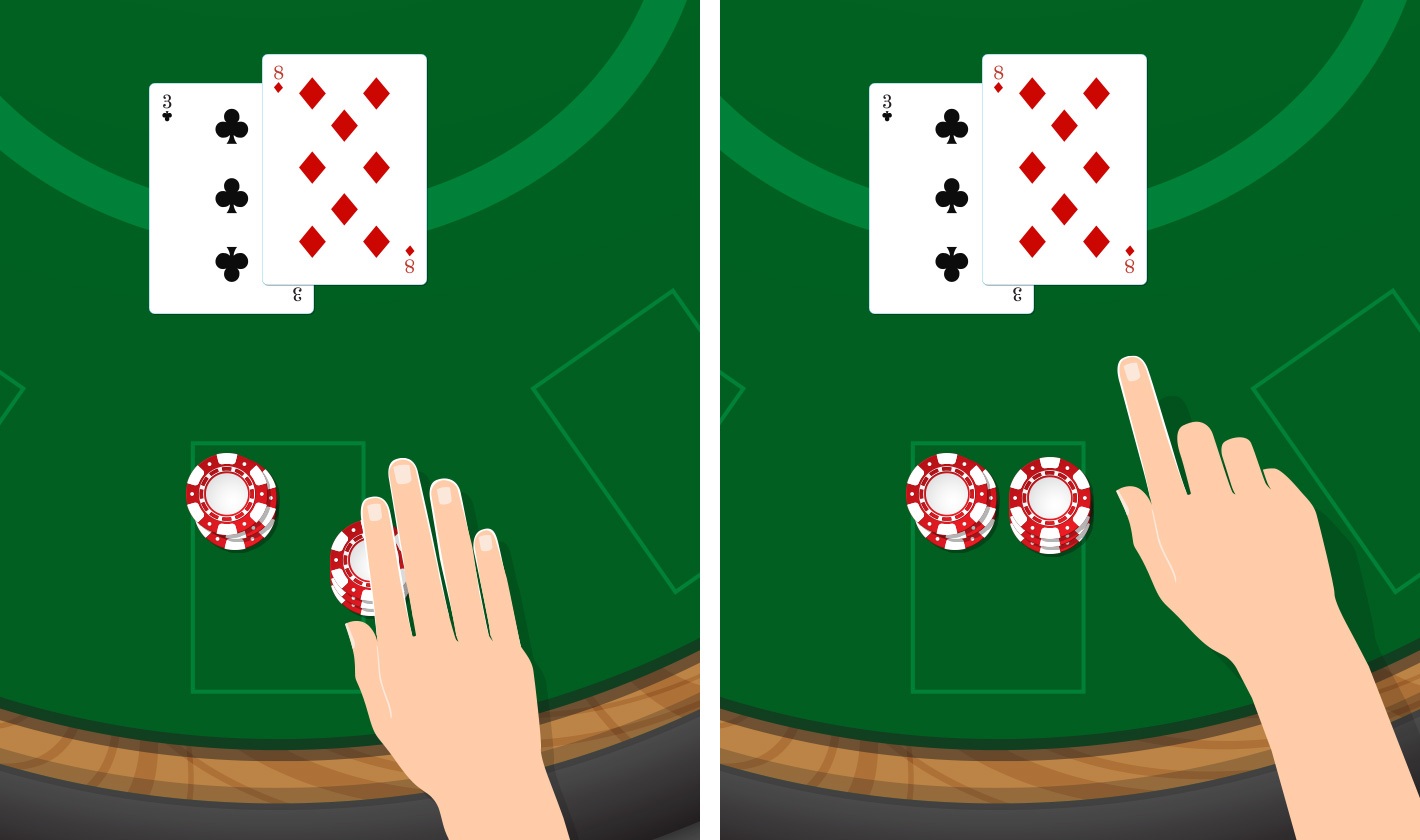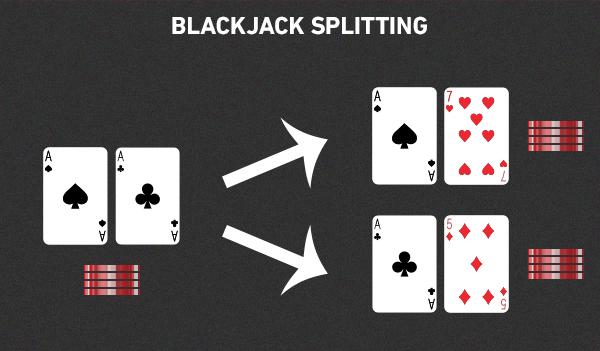When To Split Cards In Blackjack
When it comes to online blackjack, splitting rules might vary depending on games variants. For instance, if you split 10s and get another 10 on one hand, you can split that too; it’s known as resplitting. Majority of variations and house rules allow it for up to three times (totaling four hands), but some don’t. Ideally, if the hand is split, it will either amount to 19 or 20 after a couple of draws or result in a push. When the dealer has a 2 – 7 card, it is highly recommended to split your 6s and 7s.
- Always split When you have ACES: ACES are rare in blackjack, but with so many pair of 10-value cards in the deck, it’s easier to get 21 when you have an ACE. Splitting ACES is one of the best cards you can play in blackjack. You should also re-split your ACES.
- Play by dealer’s card; Always Split Pairs In Blackjack. Remembering when it’s always good to split in blackjack is easy. This rule only applies to two pairs – aces and eights. There is a very simple reason for splitting aces. The maximum value of two aces is 12 (11 + 1). The only card to make a blackjack.
- When to Split Sixes. Split a pair of sixes when the dealer shows 2, 3, 4, 5, 6. Based on the mathematical calculations, your hard 12 can give you a better result, when the dealer has 7 or more, and your six in hand can result in a stronger combination when the dealer has less than 7.
How Splitting in Blackjack Works?
What splitting in blackjack means is that when your hand consists of two cards with similar value, you can split them by placing additional bet, creating two hands that will be played separately. The option to split is of enormous value; if it’s used wisely of course.
The basic idea behind splitting cards, besides the obvious goal of increasing your winnings, is twofold. First, to improve weak hands, splitting 8s are a clear example for that. Second, to increase possible winnings on stronger hands, for example splitting Aces.
As with every blackjack rule, things are very simple and yet complicated in the same time. Using this option when not needed, which is probably the most common mistake when it comes to splitting in blackjack, can cost you a lot of money. The good news is that the splitting strategy is rather straight forward and easy to remember, especially if you have a favorite blackjack game which you come back to. Otherwise, it varies according to the specific splitting rules which we will review below.
Last thing before we continue, many new players not sure or shy to request to split, double and so forth. Don’t be. You don’t need to know any secret signs or terminology. Just tell the dealer that you wish to split and place additional bet. That’s it. Of course if you play blackjack online things are much easier and all you have to do is press the split button.
Common Blackjack Split Rules
- Allowed to split twice (up to three hands).
- You can split non identical 10 value cards.
- Splits Aces cannot be re-split.
- Split Aces receive only one card.
- You can hit and double down split hands.
Let’s take basic basic Vegas Strip hole card blackjack rulesand see how different splitting rules influence the house edge. So additional rules we use: 8 decks, dealer checks for blackjack and stands on soft 17; double down on any 2 cards; blackjack pays 3:2. Under the splitting rules we used above the expected payout is 99.56% (or house edge of 0.44%).
Below you can see how each change influence the odds (+ means increases players’ odds, minus – lowers players’ odds):
- Only 1 split allowed: -0.045%
- Allowed to split to 4 hands: 0.01%
- No double after split: -0.14%
- Player can re-split Aces: 0.06%
- You can hit split Aces: 0.19%
When to Split in Blackjack – Basic Strategy
We will try to make it simple to remember. Here we won’t explain the mathematics behind each decision, but you can find it in additional articles.
Most crucial ones:
- Never Split 5s and 10 value cards. (Double on 5s as you would on any hard 10).
- Always split Aces and 8s.
The easy ones to remember:
- 2s, 3s, 7s – split when dealer shows 2-7
- 6s – split on dealer’s 2-6.
And the unique ones:
- 4s – are not a perfect hand for splitting, so you should split them only when the dealer shows 5 or 6 and only when you can double after split. If the casino doesn’t allow to double on split hands – never split 4s.
- 9s – split on dealer’s 2-6 and 8,9.
Best Casinos to Play
If you’ve ever played blackjack, you already know that if you get two identical cards in a hand, you can split them into two separate hands. This action is referred to as a “split”. These two hands are then treated as two separate players. Each of them may be split again (in case of getting another identical card) or doubled.
The basic strategy for blackjack clearly defines the situations when the player should split cards in blackjack and when to play without splitting them. This knowledge is absolutely crucial for most professional players because it reduces the house edge and in addition, gives the player a substantial chance of winning.
Generally speaking, according to the optimal strategy, there are three options for a hand consisting of two identical cards:
- Always split pairs
- Never split pairs
- Play by dealer’s card
Always Split Pairs In Blackjack
Remembering when it’s always good to split in blackjack is easy. This rule only applies to two pairs – aces and eights. There is a very simple reason for splitting aces. The maximum value of two aces is 12 (11 + 1). The only card to make a blackjack from 12 is 9. A much more likely scenario occurs when the player gets another card with a value of 10. This case may result either in bust (exceeded 21) or a 12 (1 + 1 + 10).
The logic behind splitting eights is very similar. The value of a pair of eights is only 16, which is a very unfortunate sum in blackjack. It is too low for winning and too high for a hit because more than two-thirds of the cards in the deck will get you over 21.
Some casinos allow a so-called resplit – splitting of a pair that has already been split. The same rule applies here, too. If possible, always resplit both eights and aces.
Never Split Pairs in Blackjack
Although it may seem illogical, it is true that a player should never split a pair of cards with a value of 10. Why? The total value is 20, which is very good and the only thing that trumps such a pair is getting an ace. The probability of this happening is, however, very small and the player is more likely to get two lower-value hands.
The next pair that should never be split is a pair of fives. By splitting them you only get a worse starting position with two weak hands. In addition, a sum of 10 is advantageous, especially if the dealer’s face card has the same or lower value.
Play by the dealer’s card
The remaining pairs are split depending on the dealer’s face card to maximize the mathematical probability of winning. The following rules apply:
- 2, 3 and 7 – always split if the dealer’s face card is 7 or lower
- 4 – split only if the dealer’s face card is 5 or 6
- 6 – split only if the dealer’s face card is 6 or lower
- 9 – always split except when dealer’s face card is 7, 10 or ace
To remember this strategy better, follow the table below.
| Pairs | 2 | 3 | 4 | 5 | 6 | 7 | 8 | 9 | 10 | A |
| 2,2 | Sp | Sp | Sp | Sp | Sp | Sp | H | H | H | H |
| 3,3 | Sp | Sp | Sp | Sp | Sp | Sp | H | H | H | H |
| 4,4 | H | H | H | Sp | Sp | H | H | H | H | H |
| 5,5 | D | D | D | D | D | D | D | D | H | H |
| 6,6 | Sp | Sp | Sp | Sp | Sp | H | H | H | H | H |
| 7,7 | Sp | Sp | Sp | Sp | Sp | Sp | H | H | H | H |
| 8,8 | Sp | Sp | Sp | Sp | Sp | Sp | Sp | Sp | Sp | Sp |
| 9,9 | Sp | Sp | Sp | Sp | Sp | S | Sp | Sp | S | S |
| 10,10 | S | S | S | S | S | S | S | S | S | S |
| Ace,Ace | Sp | Sp | Sp | Sp | Sp | Sp | Sp | Sp | Sp | Sp |
Splitting Cards Blackjack

Legend:
| S | Stand |
| Sp | Split |
| D | Double |
| H | Hit |
Splitting pairs for card counters
As usual with blackjack, players using card counting techniques may in some cases deviate from the optimal strategy. Most often we see this in case of insurance that is otherwise considered disadvantageous – a sucker bet. However, this is also the case with the splitting rules. In some cases, card counters shouldn’t split a pair of aces or should split a pair of tens.
When To Split Cards In Blackjack Practice
First, we will show how card counting can affect the player’s decision. If the card count is high and positive (e.g. +5, +6 or more), it is obviously advantageous to split the aces because the player knows that the deck contains more cards worth 10 which means a greater chance of blackjack.

The player will not split aces if the value is negative. In this case, the deck contains fewer cards with a value lower than 10. At the same time, the dealer should have a high card, i.e. a card with a value of 8, 9 or 10. We’ll show an example.
Let’s say the player has two aces and his count is -5. The dealer has a card with a value of 10. The player splits the pair according to the optimal strategy, and the next cards he gets are 3 and 5. After splitting, it is no longer possible to play, so he has to face the dealer’s card with a value of 10 and hands worth only 14 and 16, respectively. That is not a very pleasant situation. In such a case, it is better not to split the aces and rather draw another card, because regardless of what the player gets, he can’t bust.
When To Split In Blackjack Chart
The same logic can also be applied to the decision whether to split cards worth 10. Generally, we should never split these cards, but there is an exception that applies if the count is negative and the dealer has a low card (e.g. 4, 5 or 6). The player thus has a higher chance of getting at least 20 on one of the hands, which is very hard to beat with a low card.